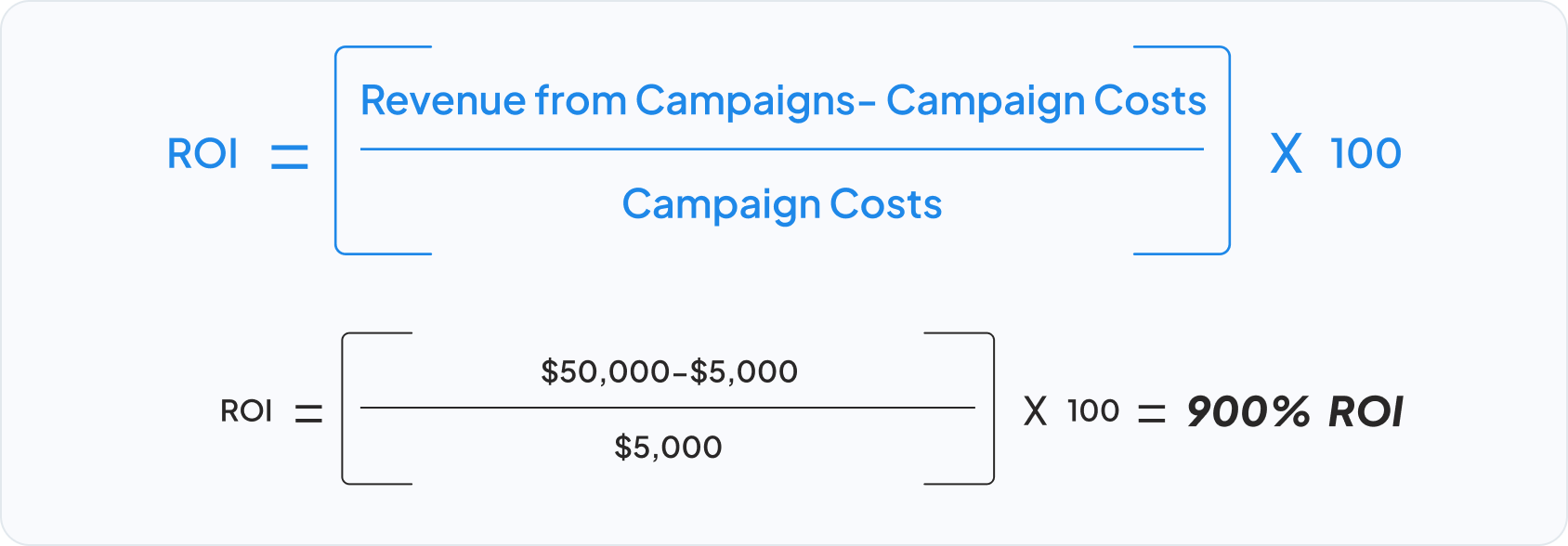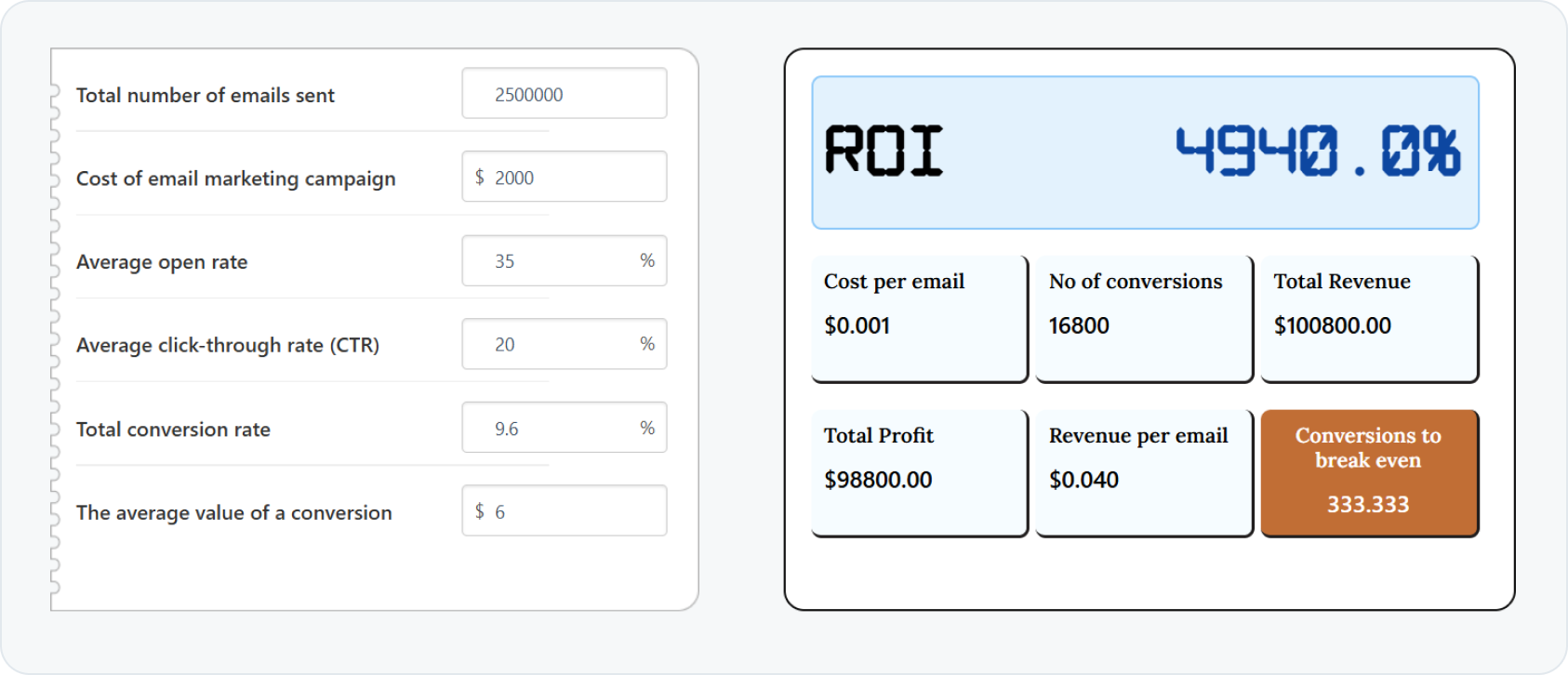As we move into 2025, email marketing continues to stand tall as one of the most effective tools for engaging customers, building relationships, and driving sales. As per studies done by Shopify, a whopping 87% of marketing leaders consider email marketing essential to their company’s success. Moreover, 52% of email professionals saw their campaign ROI double between 2022 and 2023. These statistics prove the unparalleled potential of email marketing.
In this blog, we’ll dive into the factors that make email marketing so impactful, explore the key metrics to track ROI and discuss how to calculate it using real data. Finally, we’ll share strategies to maximize your returns in 2025 and beyond.
Email ROI statistics across industries
According to the Litmus survey, email marketing delivers an impressive ROI, with an average of $36 earned for every $1 spent which is 3,500% ROI. Some studies have reported even higher numbers, reaching up to $44 for every $1 spent, outshining every other marketing channel.

Even in industries with the lowest ROI, such as media, publishing, events, sports, and entertainment, the return is still impressive at 3200%. But these figures aren’t just theoretical. They highlight how businesses, when equipped with the right strategies, can achieve tangible and exceptional results.
How does Email marketing deliver such high ROI?
Email marketing’s dominance lies in its cost efficiency, scalability, and ability to engage audiences effectively. Here’s why it delivers such impressive returns:
1. Low cost, high reach
Email marketing offers an affordable way to connect with your audience. Unlike traditional media like TV or print ads, it requires minimal upfront investment. It also scales easily, enabling businesses to grow their reach without incurring significant additional costs.
2. Segmentation and personalization
Research shows that segmented campaigns drive 760% more revenue, and personalized subject lines increase open rates by 26%. Reaching the right audience with tailored, relevant content drives engagement and higher conversions.
3. Automation and consistency
Automation reduces manual effort while ensuring consistent, personalized communication. Automated workflows like welcome emails or abandoned cart reminders streamline customer journeys, improving lifetime value and overall ROI.
4. Customer retention
Retaining customers is far more cost-effective than acquiring new ones. Regular email communication keeps your brand top of mind, fostering loyalty. Studies show repeat customers spend 67% more than new ones, underscoring the importance of email as a retention tool.
5. Measurability and optimization
Email marketing allows businesses to test, measure, and refine campaigns in real time. With tools like A/B testing and detailed performance analytics, marketers can make data-driven improvements to maximize results.
Key metrics to track email ROI
Measuring ROI isn’t just about tracking revenue, it’s about understanding the factors driving it.
- Open rate
The percentage of recipients who open your email

- Click-through rate (CTR)
The percentage of recipients who click on links in your email

- Conversion rate
The percentage of recipients who complete a desired action, such as making a purchase

- Bounce rate
The percentage of emails that fail to reach recipients’ inboxes

Tip: Bounce rate affects deliverability. Ensure that the contact list is refined regularly and that sending IP addresses and domains have good reputations and aren’t flagged as spam.
How to calculate ROI
Let’s understand how to calculate ROI with an example,
A B2B software company uses email marketing to nurture leads over a period of 3 months. After sending a series of educational emails, product demos, and personalized offers, they generate $50,000 in sales from a $5,000 investment in the campaign. The ROI would be:
The most straightforward formula to calculate ROI is:

Note: While the formula itself is simple, determining the revenue generated from campaigns and accurately calculating total campaign costs can be time-consuming and confusing when done manually.
Track your returns: Leverage our ROI calculator
You don’t have to do the heavy lifting manually, just leverage Kasplo’s ROI Calculator by inputting the necessary data metrics and discover how much your emails are truly earning!
- Total no of emails sent
- Cost of email marketing campaign
- Average open rate
- Average CTR
Total conversion rate
- Average value of conversion
Consider,
An e-commerce business runs a seasonal email campaign offering 20% off on specific products. With a well-targeted email list and personalized offers, they manage to generate $100,000 in revenue from a $2,000 email campaign spend. Using the insights, their ROI would be:

With this data, the calculator generates key insights to evaluate and optimize your campaign’s performance, like:
- Cost per Email to understand the cost-effectiveness of each email sent.
- Number of Conversions to see the exact impact of your campaign in driving results.
- Total Revenue to get a clear picture of the revenue generated from your email efforts.
- Total Profit to measure profitability after deducting all campaign costs.
- Revenue per Email to analyze how much revenue each email contributes to your overall success.
- Conversions to Break Even to identify how many conversions are needed to recover your investment.
Our ROI Calculator goes beyond just numbers. It provides actionable insights to help you make informed decisions, optimize campaigns, and achieve greater profitability.
Get actionable insights & optimize campaigns to achieve greater profitability
Proven strategies to achieve ROI excellence
- Focus on quality over quantity
Avoid sending too many emails aimlessly, which leads to unsubscribes or audience fatigue. Moreover, segment your list and send emails only to targeted groups that are more likely to engage.
- Minimize campaign costs without compromising on performance
Utilize cost-effective tools like Kasplo for email creation and automation. Prioritize campaigns with a history of delivering high ROI, such as seasonal promotions or upselling emails.
- Maximize Revenue Per Conversion
Promote higher-value products or services through upselling and cross-selling emails. Introduce discounts for larger purchases to increase average transaction value. Leverage dynamic product recommendations tailored to past purchases or browsing behavior.
- Optimize using analytics
Utilize automated workflows for nurturing leads, onboarding new users, and reactivating dormant subscribers. Regularly test and monitor key metrics to identify areas for improvement and adjust campaigns in real time.
Wrapping up
In conclusion, focusing on ROI metrics and leveraging tools for accurate calculation is essential for businesses to make the most of their email marketing campaigns. Tracking key metrics like open rates, click-through rates, and conversion rates provides valuable insights into campaign performance and areas for improvement. Using tools such as ROI calculator, businesses can easily evaluate their campaign profitability, identify trends, and optimize their strategies with data-driven precision. By prioritizing these practices, companies can maximize their returns, refine their email marketing approach, and sustain long-term growth in an increasingly competitive digital landscape.


